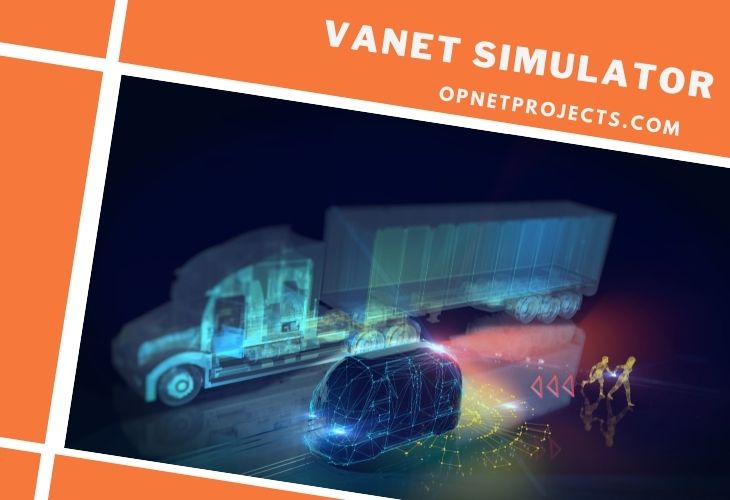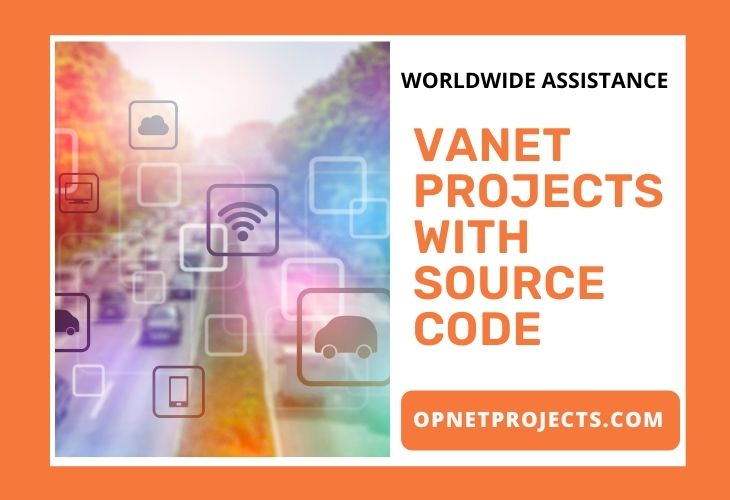Vehicular Ad Hoc Network (VANET Simulator) network is a spontaneous ad-hoc network for dynamic vehicles to create real-time vehicular communication. Vanet Simulator Projects with source code is offering full-fledged top to bottom research services in the VANET area for scholars.
The reason behind this fast popularity lies in the growing importance of intelligent transportation system construction. In particular, VANET characteristics grab the attention of recent research followers. The features include increasing mobility, network partitioning, intermittent connectivity, obstacles in environs, and routing challenges.
This page specifically emphasis on recent research ideas, key characteristics, protocols, development tools using VANET Simulator for active researchers. Surely, towards the end of the section, you will find more responsiveness in this area.

Key Features of Vehicular Ad Hoc Networks
Nowadays, Vehicular Ad-hoc Networks (VANET) have become one of the widespread PhD/MS study areas in the research community. Due to this tremendous research demand in vehicular communications, our researcher team is concentrating on all VANET aspects. And some of them are spotted as Channel Modelling, Medium-Access-Layer (MAC) Procedures Design with Scalability, Security and Privacy Policies, Consistency and Latency Enhancements, VANET-LTE Integration, and Routing protocols with Adaptability in Network Topology.
Next, have a look at the necessary protocols for establishing V2V or V2I Communication. It encompasses a set of rules to regulate the data transmission flow despite varying internal procedures, construction, and model using vanet simulator.
What are the protocols in VANET Communication?
- CSMA/CA Protocol
- Location aware Routing Protocol
- Traffic aware Routing Protocol
- WAVE-compliant MAC Protocol
- Predicted Position using Routing Protocol (PPRP)
- Location Management Protocol
- Cooperative Volunteer Protocol
- Secure Information Protocol (SIP)
- Routing Protocol using Topology
- Intelligent UAV-aware Routing Protocol
- Position based Routing Protocol for GPSR and BMFR
- Routing Protocols:
- OLSR
- GPSR
- AODV
- DSDV
- DSR
- MAC-Layer Protocols:
- IEEE 802.11
- IEEE 802.11p
- IEEE1609
- IEEE 802.16e
To be sure, our hand-picked ideas bring up a new dimension for your research work.
In some cases, if you are surfing for finding an excellent R&D team to build your own idea, then we are ready to do that too. We also suggest a better solution to yield absolute results programming with vanet simulator.
Research Topics in VANET Simulator
- MAC Scheduling
- Multiple-Hop Routing
- Network Partitioning
- Selection of Relay or Forwarder
- Secure Authentication Mechanism
- Data dissemination for Emergency cases
When it comes to code development part, one should be more aware in tools that allow simulation. For accurate VANET outcomes, our Vanet Projects with source code have pointed out few widely using network simulation tools.

Important Simulation Tools in VANET
- NS3 with SUMO
- Using GPS Open Street Map, create mobility information through traffic generator
- Next associate real time traffic from SUMO with NS3 simulator
- Then examine average packet success ratio and throughput of real traffic using different routing protocols
- Finally, proves that the designed model yields better results in high traffic and dynamic environment
- As well, shows that the transmitter is suits for V2V communication
- NS-2 with MobiSim
- Most probable simulations in CARLINK are done through the combo of traffic simulator VANET Simulator, MobiSim and NS2 simulators
- Appropriate for packet-level modelling on more number of protocols
- Furnishes with lot of wired networks, wireless propagation, various multicast forms, message / satellite broadcasting, ad-hoc transport and routing protocols, etc.
- Composed of several traffic generators as web, telnet, Constant Bit Rate, etc
- Includes TraceGraph and Network Animator graphing software
- EstiNet
- EstiNet network simulator and emulator has an optional add-on feature for VANET Simulator module
- Supports road-building function to pretend vehicular traffic which can be constructed by hand or by importing a roadmap file
- Improves the human behaviour in driving
- Provisions with both vehicular traffic simulation and V2V/V2I communication simulation
- Utilizes IEEE 802.11p, IEEE 1609.3, and IEEE 1609.4 protocols for V2V/V2I Networking
- Protocols are designed to support Wireless Access in Vehicular Environments (WAVE) with low latency and high quality under dynamic vehicular mobility
- Omnet Veins
- Omnet++ provides a compilation of extensions wholly designed in Veins
- Supports very realistic simulations of Vehicle to Vehicle / Pedestrian / Home / Infrastructure and so on
- In Vehicle-to-Everything (V2X) network, create any kinds of realistic roadmap with protocol stacks of real network.
- Veins smoothly operates on SUMO under Omnet
- Also, Veins is allowed to use traffic models for mobility scenarios and patterns in an organized manner.
- OpenNet
- Use models of real vehicular mobility to enhances Opnet Modeler simulation scenario
- Supports Sumo for the simulation of Vehicular Ad hoc Networks
- Adapt special kind of Mobile Ad-Hoc Networks (MANET) to launch communication between vehicles
- Practice several specific VANETs protocols to meet vehicular application requirements by advance performances
- Requires some realistic mobility models for protocol evaluation
- NS2 with SUMO
- SUMO stands for Simulation of Urban Mobility software which is used for road traffic simulation
- Here, Road Side Units (RSUs) like base station, access points are installed at every cross point as static node
- Then Vehicles are passing through cross point as dynamic nodes and enters into particular path to compute the traffic among two cross points
- NS2 is used to simulate the scenario, AODV protocol is used to estimate the traffic and SUMO vanet is used for graphical demonstration.
- Mininet
- Performs emulation based on the node’s deployment
- Resources Management in dynamic vehicular situations through IEEE 802.11 standard
- Supports large number of applications as follows,
- Vehicular application (road safety, traffic efficiency, and infotainment)
- Driving alertness and direction (local, context, and cooperative awareness)
- Zero-accident driving automation (e.g., platooning and autonomous driving)
Other Simulators in VANET
- NetSim
- Qualnet
- Mininet
- Matlab
- Opnet
- And many more
How to start Master Thesis Writing for Vanet Projects?
Writing a Master’s Thesis is a colossal responsibility for every scholar. For the finest guidance and assistance, you can tie up with Vanet Simulator Projects with source code, surely our deep-rooted writers and experts deliver your thesis as a work of genius despite challenges. For your convenience, our innovative writers have specified some important things to be followed in Master Thesis Writing.
Let’s have a look over guidelines for Master Thesis Writing,
- At first, proper planning which is the most important phase
- Next hand-pick the materials and methods wisely
- Be consistent and estimate worth of the work
- Create a well-organized schedule and follow it
- Minimize distractions in the concept
- Figure out the scope of the study
- Identify the limitations in Theoretical conventions.
- Discuss the limitations in Methodological assumptions
- Think about what figures, graphs or charts you want to use
If you are hunting for fast and professional thesis writing, then you can contact us. Well, our experts are happy to assist in Vanet Simulator Projects your needy time. Not only in the thesis, our services extended in all phases of the PhD/MS research journey.
